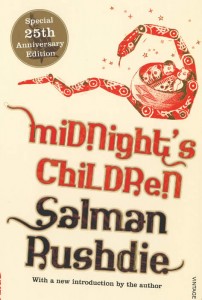In Midnight’s Children, Salman Rushdie creates a place of belonging through the acts of his narrator’s imagination. Romanticizing the Bombay of his childhood, Rushdie is in many ways restoring the past to himself. In other ways, he is clearly haunted by the sense of loss that he feels – this sense of loss is further dramatized by his inability to fully understand, to fully grasp, what has been lost in the diasporic framework of his life.
It is through Saleem Sinai, the story’s narrator, that – on the one hand – we are presented with an individual account of the diasporic identity; while, on the other hand, Saleem’s history is also the history of a diasporic nation in its making.
Saleem’s story is multivocal and metronomic: it, therefore “sounds” distinctly oral, as opposed to sounding “written.” In this way, of course, Rushdie is reminding us that history itself is very much an amalgamation of fiction.
Memory is important for the diasporic subject: it is as much their romanticized connection with their homeland as it is the moth-eaten sheet that partitions off and visibly segregates them from their new, imagined homeland. Fittingly, at the end of Book Two, Saleem is brained by a flying spittoon; on the one hand, this appears to liberate him from his past.
But for Saleem to lose his memory is, in effect, to lose his identity. Memory prevents the postcolonial subject from forgetting their historical and social space – a space that has been created, however, through disruption of history.
In one way, the “chutnification” of Rushdie’s narrative and narrated subjects in Midnight’s Children has an international and cosmopolitan sensibility attached to it: it remembers Indian history through the use of tropes.
In another way, it (chutnification) is related to the way in which memory can be used in a high modernist text – thus reconciling how we think about “tradition” within modernity. But it also creates a specific kind of linguistic consciousness: it positions the writer as the constant translator, the speaker with forked tongues.
This form of hybridization within the text is a central trope of both colonial and postcolonial writing. Hence there is migration and diaspora constantly re-occurring within the authorial voice: this crucially makes the reader an active truth-interpreter, as opposed to a passive observer, of narrative events.
Saleem believes that “nobody from Bombay should be without a basic film vocabulary” (33): he is familiar with the conventions of Bollywood, and he appropriates these conventions in the construction of his narrative and in the manipulation of action in the novel.
At times, the narrative camera provides the closest of close-ups; at other times, the reader seems to be at a very distant remove from the action.
The most effective image that links the “cinematography” of the novel to the question of diasporic identity occurs at the very beginning of the chapter titled “All-India Radio.” Rushdie is driving home the fact that, while we can – to a certain degree – see where we have come from, we are utterly incapable of locating ourselves in the present or positioning ourselves in the future.
The closer we get to the present, the more fragmented and grainy our perspective becomes. After all, says Saleem, the reality is a question of perspective; the further you get from the past, the more concrete and plausible it seems – but as you approach the present, it inevitably seems more and more incredible.
Suppose yourself in a large cinema, sitting at first in the back row, and gradually moving up, row by row, until your nose is almost pressed against the screen. Gradually the stars’ faces dissolve into dancing grain; tiny details assume grotesque proportions; the illusion dissolves – or rather, it becomes clear that the illusion itself is reality…(165-6)
The filmatic gaze of Midnight’s Children often manages to blur the divisions between the perceived reality that the reader constructs for him/herself and the supposedly factual/historical account of the (controlling) narrator.
The ambiguity of these contrasting viewpoints not only forces the Western reader to acknowledge their own biases, but it also frees the Westerner to admit that they cannot begin to comprehend the tight-rope walk that is embodied within the diasporic identity.
Put another way, the further one distances oneself from any pattern of thinking that attempts to grasp the diasporic struggle, the more lucidly they believe their grasp of the dichotomy. But to actually come close to it, to envision what it really means, what it feels like to be caught between cultures, is to finally realize (ironically) one’s true distance from the struggle.
Midnight’s Children compels us to probe beyond simple moralism; it compels us to analyze the attitudes which could trap such an individual as Saleem in the predicament of history itself. Saleem’s tragedy is to find himself stranded back in time, far from the foreshadowed future that is secured by the novel’s utopian subtext.
Saleem is as fragmentary in “death” (in that all characters “die” at the end of the novel) as the novel is itself; and Saleem – a fully hybridized text – can and does fall between the postmodern, heteroglossic extreme on the one hand, and the (postcolonial) nationally specific viewpoint on the other.

